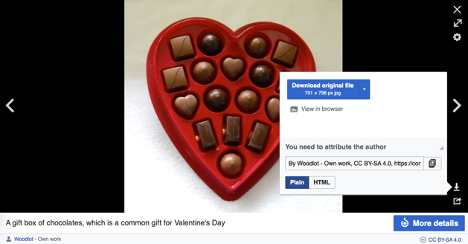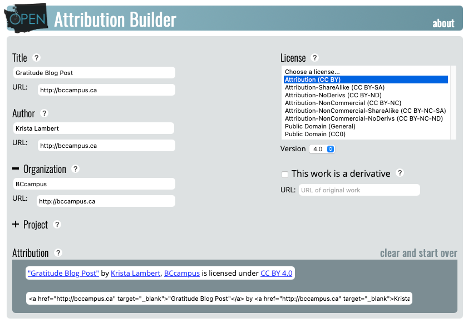In the spirit of spreadin’ love, today we want to share a call to action to express gratitude — especially as it relates to open education. Let me explain.
Post by Krista Lambert, Project Manager, ABE/Health Zero Textbook Cost Programs, BCcampus
Back in 2017, when we were able to host conferences in person (the good old days), we had the pleasure of having then-CEO of Creative Commons Ryan Merkley as a keynote speaker at the BCcampus Open Textbook Summit.
During his talk, Ryan Merkley described what makes a successful commons — and also drew on Elinor Ostrom’s work, on the tragedy of the commons, to touch on scarcity in the digital commons. “What is scarce about an abundant digital commons?” said Ryan Merkley. “Four things: collective action, community, collaboration, and gratitude. They are renewable. They are vital. But they are unfortunately rare.”
Gratitude. This particular point resonated with us. It’s something that can easily be expressed, makes a world of difference, and, as Ryan Merkley said, is renewable but rare.
Fast forward to present day, and we’d like to share a brief story that expresses gratitude and provide a how-to guide to get you started.
Expressing Gratitude
For the past two years, Christine Miller, Adult Basic Education science instructor at Thompson Rivers University (TRU), has been diligently working away at building and adapting an open textbook for Human Biology. She’s worked very hard to create H5P interactions, enhancing the text with stunning, diverse images and including local Indigenous content. It’s a beautiful book, and we encourage you to take a peek if you’re looking for inspiration. (The linked page contains samples of all these elements on one page.)
If you do take a look, you’ll notice Christine Miller relied heavily on images from the website Unsplash. Although these images aren’t Creative Commons licensed, they are free to use. Unsplash asks that you say thanks to the photographer for sharing.
Upon completion of this textbook in December, Christine Miller reached out to over 200 photographers to let them know she appreciated them sharing their photos, and she also sent a link to their photo in the textbook.
She did this on a Friday afternoon and didn’t really expect any replies. On Monday morning, her inbox was full! People were excited to hear that their photos had ended up in a textbook, and a few of them let her know they were going to tweet, blog, and post on Instagram about it.
Some of the responses included:
“Glad I could help, Christine. That’s why I put so many images on Unsplash. Thx for showing me where the image was used. Much appreciated.”
“Thank you so much for taking the time to reach out to me. I love seeing how my photos are being used, and I’m so glad I could help you build textbooks for your students.”
“Thank you for letting me know that you used my photograph! I’m delighted to forward the cause of making open textbooks available (and may take a read through the rest of the textbook for the fun of it, because I am an incredible nerd). Of course, your students may not appreciate the work that’s gone into making their textbook, because it looks so professional. I love seeing video links at the end of the chapter; it’s great that digital textbooks allow you to drop in direct links like that.”
“Thank you so much for sending me this. It really keeps me motivated to upload even more.”
“Awesome. From our trip to Ethiopia with my girlfriend, who has Ethiopian parents. Thanks for the link. Greetings from Berlin.”
“No way; this is so cool! It’s a cool connection because in my regular life I work for Trinity Western University and often process a lot of TRU transcripts. Your institution is dear to my heart, haha. It would’ve been even better if the people in the photo were TRU alum, but I don’t think any of them attended. Thanks for choosing some of my photos and for reaching out!”
As you can see from the responses, Christine Miller used content from global creators. It’s a phenomenal example of how creating and adapting an open work may draw on content and contributions from around the world.
Christine Miller’s act of gratitude was a small one but did not go unnoticed. We hope that by sharing this action, it inspires you to intertwine this principle into your open pedagogy. Christine Miller’s contributions are commendable and make her a trailblazer in the sphere of open education.
Acknowledgement
During the Q&A period of Ryan Merkley’s keynote, an audience member asked about ways to give gratitude. “We take gratitude very broadly, and I think one of the most basic elements of gratitude is attribution,” he said. “The least you can do to give gratitude to someone is to acknowledge that [the creator] made that thing and acknowledge it. And you’ll notice in my slides when I use an image that is CC0 and requires no attribution, I attribute anyway… One of the areas I’ve been focused on in the last year has been photographers, and one of the things that I’ve seen them most frustrated about is the ways in which their works travel around the web, and they never find out where they go, and they never hear back from those who use them. And they often don’t get credit.”
According to Ryan Merkley, one of the struggles is that attribution can be difficult. Today we’ll show you some simple ways to attribute images (even CC0 or free images) and how to find contact info for photographers, like Christine Miller did.
Attribution and Reaching Out
In this section, we detail how to attribute and express gratitude to open textbook authors, Unsplash photographers and Wikimedia contributors, and how to use the Open Washington Attribution Builder tool. You’ll also find some sample email text.
Textbook Adoptions
When you adopt an open textbook, whether it be from the B.C. Open Textbook Collection or another source, we encourage you to thank the authors in a variety of ways. You may want to send an email to the authors, mention or cite them in a presentation, or share their work on social media. Remember, citation is a form of gratitude!
Unsplash
When you’ve found an image on Unsplash you want to use, click the Download Free button in the top right corner. A pop-up message displays with the attribution. Click the copy icon (or highlight and copy) to add the attribution to your work.

To thank Unsplash photographers for sharing their work, click the user ID. This takes you to their profile page, which likely has a link to their website or social media. In the true spirit of this post, we reached out to the photographer of the heart image to thank her.
Wikimedia
On Wikipedia, when you click any image in an article, the Wikimedia viewer pops up. In the bottom right corner, click the download icon to display text you can copy and paste to attribute the author.

Wikipedia/Wikimedia also make it easy to express gratitude to content creators. When you are logged in, click a user’s profile and find the heart in the upper-right corner, where you can share some WikiLove! Again, in the spirit of this post, we left Woodlot some WikiLove for sharing this image.

Open Washington Attribution Builder
Washington State Board for Community and Technical colleges (WA SBCTC) built this application to help you easily cite open material. Fill out the form, and the application automatically generates an attribution statement for you.
Each field has a ? icon that provides more information about what information you should add.

And, you guessed it, we reached out to the folks at WA SBCTC to thank them for building and maintaining the Open Attribution Builder. It’s such an awesome tool!
Email Template
Here’s the sample email that Christine Miller wrote to creators to give you an idea about what to include in an email message:
Hi,
I just wanted to let you know I’ve used one of your lovely photos in an open textbook about human biology.
Thank you for putting your work on Unsplash so that teachers like me can make beautiful, free textbooks for our students.
If you’re interested in seeing where your work ended up, you can see it here (url) in a section about (topic).
Call to Action
Now that you’ve learned some ways to spread love, we challenge you to reach out to creators and thank them for the work you use. Perhaps this is a textbook author for a textbook you’ve adopted, or maybe it’s thanking a photographer for their image. Another option is to tag a creator on Twitter or Instagram to thank and share their work. We encourage you to use the hashtag #OpenGratitude.
Starting today, BCcampus is committing to giving attribution to the photographers of the openly licensed photos we feature on our blog.
The feature image for this post (viewable in the BCcampus News section at the bottom of our homepage) is by Rahul Pandit from Pexels.
To stay up-to-date on all the latest news and events make sure you subscribe to our newsletter.
